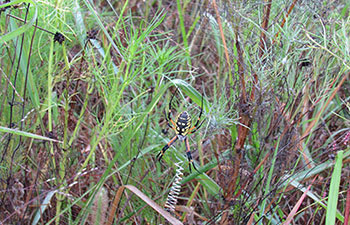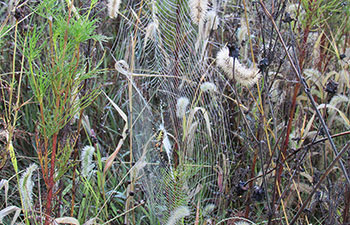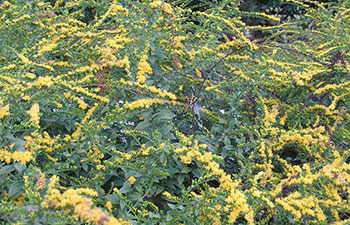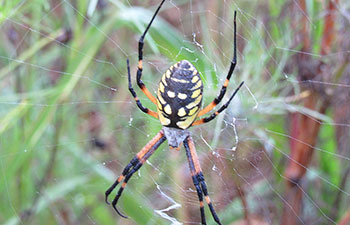Large and Beautiful, the Southern Garden Spider
Large and Beautiful, the Southern Garden Spider
By Bill Willis and Bill Steinmetz
November 16, 2017

Photo courtesy of Bill Willis
Story Highlights
- The Garden Spider is very attractive and a welcome guest in the garden
- This spider is one of the larger and showier southeastern spiders
- It can trap large insects like moths and grasshoppers
This year has been a very good year for spiders in the wildflower meadows on Lakeview Drive and the Memorial Garden. Seeing a lot of spiders is often indicative of a plentiful food supply in the form of insects. Garden Spiders (Arglope aurantia) are also called yellow, golden, black and yellow, writing, or corn garden spider.

Photo courtesy of Bill Willis
Habitat Set-Up
This spider frequently occupies a sunny location out of the wind. The female eats the center of the web and then rebuilds it each morning, as the web may provide some nutrition. During the day, she moves to the center, where she can make the web oscillate, back and forth. This action helps attract small prey as well as confuse birds or other insect that might prey on her. The male is small and plain and is often nearby in a less showy web. Although their main diet is insects, small lizards may be consumed.

Photo courtesy of Bill Willis
Females may breed twice a year. With males lingering in the wings and intent on mating, a successful interaction is usually possible. He transfers a sperm packet to her. For his efforts he is then either eaten during the process or dies shortly after. Eggs are laid on a silk sheet that is incased into a tough egg sac. Each sac could contain a thousand eggs. It’s possible that a healthy female could produce four egg sacs. The female will guard the sacs until cold weather kills her. The young will emerge when it is warmer and disperse into the surrounding vegetation.
The Garden Spider is not aggressive but will bite if harassed. Their bite is comparable to a bee sting.
Enjoy their beauty and benefits in the gardens and meadows.

Photo courtesy of Bill Willis

Photo courtesy of Bill Willis

Photo courtesy of Bill Willis

Photo courtesy of Bill Willis



